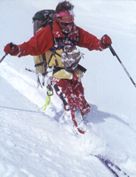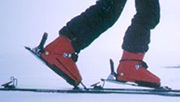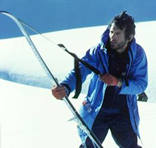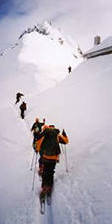|
|
|
Ski Mountaineering: an introduction
 Not
so long ago, skiing was something mountaineers, British ones anyway,
regarded with suspicion. Like eating quiche, real climbers didn't
ski. If they did, it was as a separate sport, a winter holiday with
the family, not to be confused with serious mountaineering. When
they went climbing in the Alps in winter, they would stolidly plug
lines of holes two feet deep up the glaciers and take days to reach
their route; or they would hire snow shoes in Chamonix and take
almost as long. Of course there were exceptions who proved the rule;
Dougal Haston, for one, and there has always been a small band of
devotees in the Eagle Ski Club and the Alpine Ski Club. But on the
whole, skis, whether as a means to an end or as an end in themselves,
were not part of the average mountaineer's equipment. Not
so long ago, skiing was something mountaineers, British ones anyway,
regarded with suspicion. Like eating quiche, real climbers didn't
ski. If they did, it was as a separate sport, a winter holiday with
the family, not to be confused with serious mountaineering. When
they went climbing in the Alps in winter, they would stolidly plug
lines of holes two feet deep up the glaciers and take days to reach
their route; or they would hire snow shoes in Chamonix and take
almost as long. Of course there were exceptions who proved the rule;
Dougal Haston, for one, and there has always been a small band of
devotees in the Eagle Ski Club and the Alpine Ski Club. But on the
whole, skis, whether as a means to an end or as an end in themselves,
were not part of the average mountaineer's equipment.
Now, all that has changed. Skiing is seen as a useful skill to
acquire and as enjoyable a form of mountaineering as rock-climbing
or ice climbing. Almost everybody is doing it. And with good reason,
for it is the only sensible way to travel in deep winter snow: easier
than walking on the uphill and as exciting or scary as you care
to make it on the descent.
Improved equipment
One reason for the growth of interest has been the improvement in
equipment. When I first went touring in 1970, I was using wooden
skis which were far too long for me, (and snapped, halfway through
the holiday). They were fitted with cable bindings which had no
lateral release, and I wore lace-up leather boots that were a pleasure
to walk in but only a slight advance on flip-flops to ski in. Consequently
I used to enjoy the uphill and survive the downhill!
Gear has come a long way since then. Boots like the Scarpa Denali
or the Nordica TR10 are almost as good as downhill boots to ski
in and nothing like as uncomfortable to walk in as they appear.
Broad modern skis have made the off-piste accessible to far more
people.
 Bindings
have altered radically, with Fritschi and Silvretta dominating the
market at present. Most are now of the step-in type, with sensitive
forward and lateral release for downhill skiing and a climbing aid
to raise the heel on steep ascents. Harscheisen (ski crampons) are
standard on most models. Ski-brakes are becoming more common as
an optional alternative to safety straps, but you do have to choose
between the possibility of losing a ski in deep snow (which does
happen) and slicing yourself open with a tip or an edge in a bad
tumble (which also happens). Bindings
have altered radically, with Fritschi and Silvretta dominating the
market at present. Most are now of the step-in type, with sensitive
forward and lateral release for downhill skiing and a climbing aid
to raise the heel on steep ascents. Harscheisen (ski crampons) are
standard on most models. Ski-brakes are becoming more common as
an optional alternative to safety straps, but you do have to choose
between the possibility of losing a ski in deep snow (which does
happen) and slicing yourself open with a tip or an edge in a bad
tumble (which also happens).
 Skins
for going uphill, which have a pile allowing the ski to slide forward
but not backwards, have improved too. They used to be made of seal
fur and were attached to the ski with straps. Now they are made
of nylon or mohair and almost universally use a sticky backing,
a system which works well so long as the bottom of the ski is dry. Skins
for going uphill, which have a pile allowing the ski to slide forward
but not backwards, have improved too. They used to be made of seal
fur and were attached to the ski with straps. Now they are made
of nylon or mohair and almost universally use a sticky backing,
a system which works well so long as the bottom of the ski is dry.
Telemark equipment
An increasingly popular alternative is telemark equipment. Bindings
are very light and boots are fastened only at the toe, with either
a three pin or a cable system. Boots need to be solid and warm but
bendy so that you can 'kick' with each stride on the flat and crouch
down to execute a telemark turn. Using this sort of gear, the High
Level Route from Chamonix to Zermatt has been skied in twenty-four
hours instead of the usual week, but you need to be a very good
telemark skier to handle that type of terrain.
Where to ski
Many people confine their ski touring to the Alps where there are
plenty of huts, good maps and guide books, reliable snow and plenty
of people around in Spring to reduce the seriousness of it all.
However, there is no lack of possibilities in Scotland, Wales and
the Lakes when the snow is right, which is admittedly less often
than it used to be. In fact, once you have the gear you can ski
anywhere there is snow which, in winter, is a sizeable chunk of
the northern hemisphere, including some less obvious destinations
like Morocco, Corsica, Lebanon and Greece.
Starting out
 To
enjoy ski mountaineering you do need to be fairly fit and you need
to be able to ski. Skiing with a pack in deep crud calls for a certain
amount of both strength and skill, and the more you have of each
the more you can enjoy it. You can get by with one or the other.
If you are very fit you can put up with frequent head-plants and
the protracted performance of putting self and skis together again
afterwards. If you are a good off-piste skier but unfit you may
be able to hang on uphill and still cope with the downhill. But
you will have the most fun if you are both. If you are neither,
your holiday could be a disaster, not only for you, but also for
the rest of the party who have to wait for you. To
enjoy ski mountaineering you do need to be fairly fit and you need
to be able to ski. Skiing with a pack in deep crud calls for a certain
amount of both strength and skill, and the more you have of each
the more you can enjoy it. You can get by with one or the other.
If you are very fit you can put up with frequent head-plants and
the protracted performance of putting self and skis together again
afterwards. If you are a good off-piste skier but unfit you may
be able to hang on uphill and still cope with the downhill. But
you will have the most fun if you are both. If you are neither,
your holiday could be a disaster, not only for you, but also for
the rest of the party who have to wait for you.
For climbers learning to ski, it is tempting to head off into the
untracked snow straightaway, but it is well worth having some lessons
and waiting until you feel confident that you can handle most pisted
slopes, one way or another, and have had a go at some off-piste.
Looking good matters not a jot, but knowing when not to fall over
and being able to traverse, side-slip and kick-turn are important
skills for getting out of trouble. It is wise to adopt a conservative
approach to your skiing, too. The back of beyond is a bad place
to break a leg.
Getting instruction
 If
you wish to start under tuition or to try out the gear at someone
else's expense, the UK national centres, Glenmore Lodge and Plas
y Brenin, run introductory courses, as do a number of British Mountain
Guides. The Eagle Ski Club has an extensive programme of guided
and unguided tours for all levels of experience in different parts
of the Alps and welcomes new members. The Ski Club of Great Britain
also has a touring programme along with ski-safaris and off-piste
holidays. If
you wish to start under tuition or to try out the gear at someone
else's expense, the UK national centres, Glenmore Lodge and Plas
y Brenin, run introductory courses, as do a number of British Mountain
Guides. The Eagle Ski Club has an extensive programme of guided
and unguided tours for all levels of experience in different parts
of the Alps and welcomes new members. The Ski Club of Great Britain
also has a touring programme along with ski-safaris and off-piste
holidays.
If you prefer to do your own thing, remember that avalanches are
a very real hazard for the skier. Learn all you can about snow,
and carry a transceiver and a shovel, just in case. The one is no
use without the other. If you don't believe me, see how long it
takes to dig a hole in the snow a metre deep with your hands. That
said, there is no finer feeling than skiing untracked powder that
you have reached on your own two feet. Go for it!
© Text and photos Rob Collister
2002 ('Starting out' photo © Dan Carron)
|
Rob
Collister is a very experienced International Mountain
Guide who has led climbing, mountaineering and ski mountaineering
tours and expeditions all over the world. He now acts as a
freelance guide as well as occasionally working in some of
the UK's leading outdoor centres and leading weekend hiking
and walking trips for his own company, Wild
Wales. Rob is also well known for writing about the outdoors,
he has produced several books and regularly writes for some
of the top outdoor magazines.
|
|

